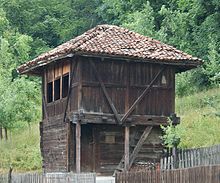Chardak
- View a machine-translated version of the Serbian article.
- Machine translation, like DeepL or Google Translate, is a useful starting point for translations, but translators must revise errors as necessary and confirm that the translation is accurate, rather than simply copy-pasting machine-translated text into the English Wikipedia.
- Consider adding a topic to this template: there are already 311 articles in the main category, and specifying
|topic=will aid in categorization. - Do not translate text that appears unreliable or low-quality. If possible, verify the text with references provided in the foreign-language article.
- You must provide copyright attribution in the edit summary accompanying your translation by providing an interlanguage link to the source of your translation. A model attribution edit summary is
Content in this edit is translated from the existing Serbian Wikipedia article at [[:sr:Чардак]]; see its history for attribution. - You may also add the template
{{Translated|sr|Чардак}}to the talk page. - For more guidance, see Wikipedia:Translation.

A chardak (Bulgarian, Macedonian and Serbian: чардак, čardak) is an old typical house in the Balkans. It is derived from the word cardak, which is a component of Ottoman Turkish house design.[1] This term, which is also called sofa, denotes an open hall of a house's upper living floor.[2]
Description
The chardak is timber-framed and usually include a hayat.[3] The design has been described as "Greek-Oriental," Southern European," and "Mediterranean".[3] It has a fortified ground floor and a wooden upper floor. This dwelling was used as a protective small fort.
Chardak can also refer to the space – a part of the central hall area – that connects the rooms of the house.[3]
Chardaks were also used as fortifications in the early modern period.[citation needed]
References
- ^ Couroucli, Maria; Marinov, Tchavdar (2017). Balkan Heritages: Negotiating History and Culture. Oxon: Taylor & Francis. p. 96. ISBN 9781472467249.
- ^ Architectural Elements of Traditional Settlements. International Association for the Study of Traditional Environments. 2008. p. 7.
- ^ a b c Daskalov, Roumen Dontchev; Mishkova, Diana; Marinov, Tchavdar; Vezenkov, Alexander (2017). Entangled Histories of the Balkans - Volume Four: Concepts, Approaches, and (Self-)Representations. Leiden: BRILL. p. 550. ISBN 978-90-04-33781-7.
- Милан Крухек: Крајишке утврде хрватског краљевства тијеком 16. стољећа, Институт за сувремену повијест - Библиотека хрватска повјесница. Загреб, 1995.
44°51′20″N 21°05′41″E / 44.8556°N 21.0947°E / 44.8556; 21.0947
- v
- t
- e











